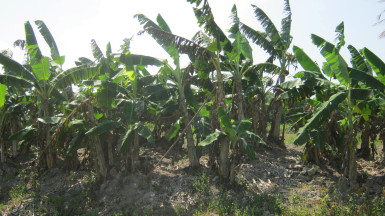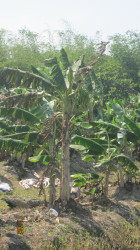Although plantain and banana farms across Guyana have been perishing under the onslaught of the Black Sigatoka Disease, resulting in a complete halt in the export of plantains, farmers are now becoming hopeful again as the disease can be controlled with very little or no effect on the quality of production.
However, some farmers believe that the cost of control is too inflated, and many have refused to follow the guidance being offered by the National Agricultural Research Extension Institute (NAREI), resulting in poor production in some areas. Nevertheless, those farmer who have followed the recommendations are now unaffected and are seeing bountiful harvests.

Dr Udho Homenauth, Director of NAREI, said that at the moment he is uncertain about the future of the export market for plantains. This is because, aside from the devastation caused by the plant disease, some local businessmen have been discussing producing plantain chips and packaging to international standards which might increase the local demand for plantains.
Dr Homenauth said NAREI has been monitoring the disease and over 100 plots with plantain and banana farms across Guyana have been under close watch.
“All the farmers who have been following the recommended management standards in planting and caring for the plants have been successful,” Dr Homenauth said, adding that the smallest bunch of plantains produced will weigh between 30 to 40 pounds, while the larger bunches will carry up to 90 pounds.
Homenauth had previously told Stabroek News that a $10 million investment in various surveys, engagements with farmers and consultations with international microbiological scientists and plant pathologists had resulted in success in managing the disease and bringing it under control.

Farmers on the Essequibo Islands have been doing very well in following the guidance and as a result their yields have been bountiful, especially on the island of Hamburg, he said.
Some of the places where extensive work was done in monitoring the disease apart from Hamburg, are Wake-naam, Parika Bank Dam and Crabwood Creek amongst other places.
The price of plantain has improved, while the quality has also been significantly enhanced and as a result many farmers have extended their acreage, Homenauth stated.
The production for 2013, was 17,000 tonnes, while 2014 had a total of 30,000 tonnes and the expectation is that some 40,000 tonnes will be produced in 2015, he said.
A farmer from Hamburg, who preferred not to give his name, said he was very happy with the guidance he received from NAREI since he has been seeing a significant difference in the quality of his plantains.
The farmer said he had lost a total of 80 acres of plantains to Black Sigatoka, he first experienced its effect on his farm in 2010. When his farm initially encountered the disease, he had about ten acres of plantains.
The first attack did not deter him and he continued to farm new grounds, the farmer said, adding that while he was encouraged by the flourishing young plants, just before the suckers matured and started producing, the disease again began spreading across his field.
Some farmers in different areas, who spoke with Stabroek News, are still ignorant of the help being offered to manage the Black Sigatoka and they continue to suffer losses while others have stopped farming plantains and bananas.
Leyland Lewis of Salem, East Bank Essequibo, has been a farmer for about 40 years, said he first experienced the disease in 2010, and lost about 35 acres of plantains.
Since the disease appeared to be overwhelming, Lewis gave up on farming plantains. However, he recently attempted to regrow the crop, invested in two acres of plantains. His two acres have since been consumed by the disease, causing the farmer to permanently give up on farming plantains.
An official from NAREI visited and offered advice in managing the disease, but Lewis said the cost of the labour force and fertilizers to manage the crop will be beyond the profitability, and he has ignored the advice. “If you have to dig a hole two feet in length and two feet depth to plant one sucker, then you can’t afford to plant more than forty suckers,” Lewis reasoned, as he detailed the cost of fertilizers and labour.
Lester Wong, a farmer in Bonasika Creek, Essequibo River, has been farming cash crops and citrus. In 2010, he ventured into plantains and started with three acres. After about six months, Wong recalled, all the healthy plants began to appear undernourished and as time progressed, his entire farm which was once flourishing with healthy green leaves was transformed into dying trees. He has never attempted to farm plantains ever since as he is afraid of losing his investment again.
Ratiebhan Singh, who has been farming at Larimakabra, East Bank Essequibo and Maripa, Essequibo River, said that he lost about 90 acres of plantains to the disease; he could not recall the exact year that he first experienced Black Sigatoka on his farms.
Singh is still farming plantains but he is very disappointed with his harvest, as he noted that his largest bunch of plantains weighs a total of thirty pounds.
Singh said he had heard that farmers were getting advice and help in relation to the disease, but he has not been a beneficiary.
Ramanand Mohabir, a farmer of Hubu, East Bank Essequibo, has also not been a beneficiary of any assistance, although he said he had learnt that other farmers had been helped with fertilizers and guidance on managing the disease. Mohabir said he will welcome any form of advice and help in managing the disease. He continues to farm on a small scale.
NAREI, over the years, has been receiving support in managing Black Sigatoka from the Caribbean Agricultural Research and Development Institute (CARDI), the government of Canada, and the United Nations (UN).
The Food and Agriculture Organisation (FAO) had announced in June that in response to the disease, two technicians from Guyana were amongst a group sent to Dominica to undergo intensive training to manage it. Other countries which were to benefit from the training included St Lucia, Grena-da, and St Vincent and the Grenadines.
According to the FAO, Black Sigatoka made its way into the Caribbean in 1991 and spread throughout the region. Guyana’s exports of plantains dropped 100% within two years of the discovery of the disease, while St Vin-cent and the Grenadines’ reduced to 90%. Barbados was the sole country to which Guyana exported plantains.
NAREI had told Stabroek News in July that the Centre for Advanced Biomedical Imaging (CABI) in the UK stated that the disease was present in samples sent to it.
Regions 1, 2, 3, 4, 7, 8 and 10, were the areas affected, according to NAREI.
Other countries affected by Black Sigatoka include Jamaica and Trinidad and Tobago.
The FAO had said that Black Sigatoka was the most destructive disease to plantains and bananas. It affects the leaves, severely impacting the plants’ ability to produce quality fruits and causes premature ripening of the fruit.
At a regional training session which was funded by the government of Canada and held at Parika recently, farmers were educated about Black Sigatoka and its management.
According to NAREI, other similar training sessions are being held in different regions.
It was explained that the selection and treatment of planting materials were vital in the management of the disease, while sanitation and ensuring that plants are supplied with adequate nutrients also play an important role.
Other aspects which were noted included, drainage and irrigation, using the correct planting density, weed and chemical control.
A plantain tree produces 42 two leaves during its lifetime, but that is significantly reduced if the tree contracts the disease. However, Black Sigatoka, if treated at the early stages, can be controlled, resulting in very little impact on the fruit produced.
Some of the suckers in Guyana which have been showing resistance to the disease include Red Cayenne, Sweet Fig and Dwarf. Homenauth told Stabroek News that NAREI is currently experimenting with a variety of other suckers checking for disease resistance and the findings will be related by the end of the year.
Some of the other services which NAREI has been offering to farmers include field visits, monitoring of the crops, soil testing and guidance on the use of pesticides.
A training programme to strengthen the capacity of Black Sigatoka management teams in the Ministry of Agriculture, as well as that of banana and plantain farmers started on September 28, and will run until October 9. The programme is a collaborative effort of the Caribbean Agricultural Research and Development Institute (CARDI) and the Caribbean Development Bank (CDB) and is being facilitated by plant pathologist Dr Robert Power of Suriname.
The illegal ‘backtrack’ crossing of the Corentyne River between Guyana and Suriname was requested to be closed in August of 2009 by the Ministry of Agriculture, Animal Husbandry and Fisheries of Suriname, owing to the spread of Black Sigatoka.
Identifying Black Sigatoka
NAREI said tiny reddish brown dots first appear on the underside of the leaves, which later progress to scattered spots all over the leaf.
These then enlarge to form a small streak, especially on both sides of the midrib by which time the spots appear brown or dark brown, especially on the third leaf of the plant.
Large dark brown spots are then visible on the underside of the leaf and black spots are seen on the upper leaf surface.
A yellow halo then forms around the spots with a brown necrotic centre.
This advances to a state where the necrotic centre becomes gray with a black border surrounded by a yellow halo.
The leaf then becomes completely withered.
Spores multiply in a 21-day cycle which results in millions of spores reproducing on a leaf.
The effect of Black Sigatoka results in damage to leaves, yield reduction up to 50% and eventual death of the plant.
The fungal disease spreads naturally by wind, water, insects, animals and humans, however, the major form of transmission is by infected leaves and diseased suckers.





